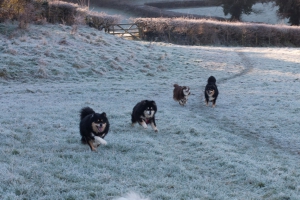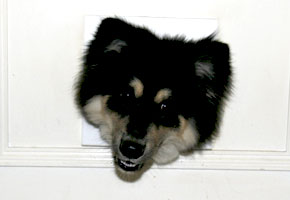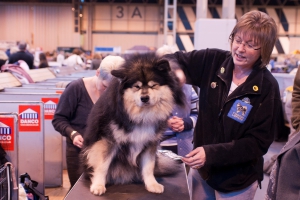Family Pets
The breed is very popular in Finland, they are a very social breed and like to be very much part of the family. We do not think they are happy as kennel dogs. Finnish Lapphunds like human company and fit in well with family life and children.
It is important, is to make sure that you get your puppy from a well-socialised litter, and from parents whose temperament suits your lifestyle. Contact a number of breeders and visit them at home before deciding from which breeder to buy your puppy. We believe that pups born into a home environment (rather than kennel) tend to be better socialised, used to noises and people etc.
You are also welcome to attend one of our many Lappy Walks that we hold throughout the year – you can find these listed on the Events page. Not forgetting you can meet lots of Finnish Lapphunds at any of the Championship Shows and at lots of local Open Shows. Again a list of Champ Shows can be found on the Event page.
Remember Finnish Lapphunds are a working breed and their temperament may lean towards strong herding instincts, plus they are not bad hunters which can make them a little wilful. They will require plenty of mental stimulation for their sanity; this is most noticeable when young, so be prepared for a very demanding puppy to join your family. You will need to be committed to spending time training your puppy.
Availability?
The breed’s popularity is rising and to date (2014) some 700+ dogs have been registered with the Kennel Club. The breed was introduced into the UK in 1989. Breeders are careful to breed for quality and not quantity, and with litter sizes being on average about five pups, the numbers have risen slowly. The Southern Finnish Lapphund Society maintains a puppy list, and they should be able to advise on puppy availability. Email us and we will be happy to put you in touch with breeders in your area or check out our breeder web page.
Colour?
The breed comes in a diverse range of colours, from cream/biscuit colour to solid black. The most common colour in the breed is the black tri colour (black, tan with with white markings). All colours are equally acceptable, and choice of colour is a personal preference. What is important is that the breed standard states that the main colour must cover the majority of the dog, so parti colours as often seen in spitz breeds are not permitted in the Finnish Lapphund (neither are brindle or saddle). See our section on colour for examples of acceptable colours.
What diseases?
- Progressive Retinal Atrophy (PRA) is an eye defect where the retina undergoes degeneration. The condition is unlikely to appear before the animal is year old, and in some breeds the age of onset maybe much later. There is now a gene test available for prcd-1 PRA and in UK it is recommended that all dogs be tested prior to breeding – unless status can be ascertained from parents. Do check with your breeder for the PRA status of their lines.
- Hip Dysplasia (HD) is a condition where the ball and socket joint of the hip is not properly formed, leading to lameness, chronic pain etc. The Kennel Club/BVA operate a scheme whereby dogs can be X-rayed and scored for the degree of dysplasia of the joint. The lower the score the better. The Kennel Club advises breeding from dogs with scores lower than the Breed average (which is currently 14 for the Finnish Lapphund). However it should be noted that HD is not a simple inherited condition, other factors such as feeding, exercise and damage may play a part in the development of the condition.
- Hereditary Cataracts (HC) Cataract is the name given to describe any opacity of the eye’s lens. The dog is subject to many forms of cataract of which only some are hereditary. Cataract appears as a whiteness or greyness of the lens, visible through the pupil. It appears that the hereditary cataract, which is seen in the FL, occurs after the dog is one year of age, and it is not believed to be progressive. The mode of inheritance of the condition is not proven. But we advise that all breeding stock be checked for the condition regularly.
- POMPE/GSD II is a storage disease which is fatal in young dogs, the breed is fortunate to have a gene test for this condition, which means that no affected puppies should be produced as all responsible breeders will be aware of the generic stats of their breeding stock. (Incidence of carriers is very small).
- Epilepsy. Idiopathic (cause unknown) epilepsy is usually thought to be inherited but as yet there is no known method of inheritance. Research to date seems to indicate the condition is slightly more common in male dogs than in bitches, with the first seizure occurring at 1-5 years old.
- Addisons – hypoadrenocorticism, or adrenal insufficiency, is an often hereditary / auto immune disease. It is most common in young and middle-aged dogs and appears to affect bitches more than dogs. Can usually be controlled by medication.
- Cushings disease is another name for hyperadrenocorticism. It is relatively common in older dogs and can often be mistaken for simple old age. Cushings disease is caused by too much cortisone being released from the adrenal gland. Some symptoms of this disease are increased drinking and urination, weight gain and loss of hair without itching. Usually affected animals respond well to treatment.
- Hypothyroidism is the most common endocrine skin disease in dogs. It results in bilateral and symmetrical hair loss. Other signs of the condition include weight gain, intolerance to cold, a slow heart rate, absence of heat cycles and lethargy.
Exercise?
Finnish Lapphunds are not for the couch potato, they are a working dog, and physical exercise is necessary to their health and well being. We would guess that on average the dogs require 1 hour of free running a day, but they can and do take a lot more if offered, enjoying a run alongside joggers and mountain bikes etc. (T hough they need to be mature before tackling strenuous exercise).lappies enjoying exercise
hough they need to be mature before tackling strenuous exercise).lappies enjoying exercise
But what is probably more important is the quality of the mental stimulation that they receive in addition to the physical stimulation. The Finnish Lapphund has a very clever and active brain, and can soon become bored. You must consider the dog’s emotional/mental needs, like training for obedience, agility, flyball etc. They love to learn so teaching them tricks is a great way to keep them stimulated as well as playing fun games.
The Finnish Lapphund is perfectly happy living with cats or other breeds of dogs. Many of the Finnish Lapphunds in the UK already share their homes with cats, and the young puppies soon develop respect for their smaller furry friends. Some even decide to try what it is like to be a cat by using the cat flap.
Bark?
The Finnish Lapphund can be vocal and if not trained correctly they will use their voice to get attention, this is commonly seen when the pups are cute and their owners respond inappropriately to a yap! Word of caution – positive reaction when young can result in a noisy, demanding Lapphund when older. The breed is very trainable, and dogs can be taught that barking is not a behaviour that you will accept. Having said that, when a large number of Lappies get together – at shows or on walks – they certainly enjoy a good chat!
Grooming?
Although the breed has a very attractive and heavy coat, they require only a small amount of grooming (about 0.5 hour a week should be adequate.). The main areas on which to concentrate being around the ears,

and the tail and long feather on the legs and under the tail. No trimming is required, although some owners may prefer to trim around the feet and under the pads to reduce the amount of mud bought into the house! Bathing is also up to personal preference – too much bathing will soften the coat and strip out the protective oils, often a good brushing will remove the dirt and dead hair sufficiently to avoid the need for a bath – but if your ‘best friend’ smells then a bath with suitable pet shampoo should be fine. If your dogs has a tendency to roll in nasty smelly substances – then it is a good idea to rub tomato ketchup into the smelly area and rinse off, ketchup seems to be the only substance that will neutralise the smell!
Dog or bitch?
For pet owners this question generally means ‘is either of the sexes easier to live with? The Finnish Lapphund male can be rather dominant with other males, but this is not to say that they cannot be kept with other males. The Society would not advise keeping two male Finnish Lapphunds together unless you are experienced with the breed. Experience shows that male Finnish Lapphunds are no more likely to stray than bitches. The males tend to be a little larger and have more coat than bitches. For the bitches you will need to consider whether to spay (neuter) or not, the bitch’s seasons (up to twice a year) can be inconvenient, messy and may produce temperament changes in the bitch as she undergoes hormonal fluctuations. Finnish Lapphunds are very social dogs and love to be with people and other dogs. Again a good relationship with your breeder will help you understand whether either sex is more or less likely to settle in your family. For many of us, this is a preference that you can only express if you have had both sexes, and then you find that you may bond better to one sex or the other.
